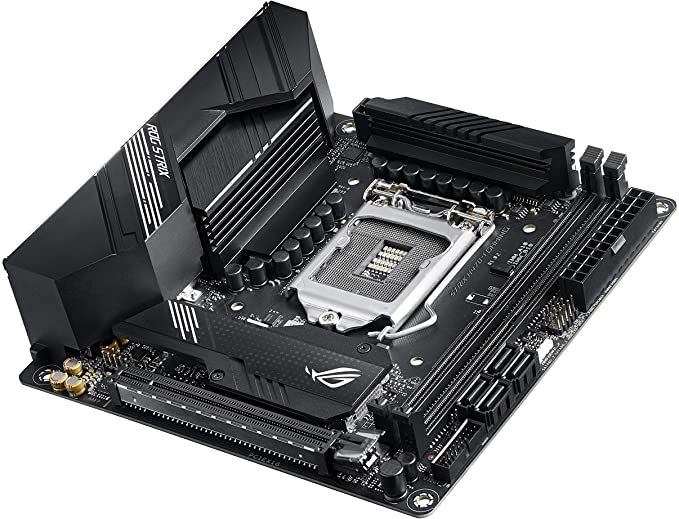Best 10th Gen Intel Mini-ITX Motherboards
The arrival of 10th generation Intel CPUs have been a storm of hardships and competition, following right after Ryzen’s 3000 series, and then followed after by Ryzen 5000. Despite mid-tier and entry-level Comet Lake CPUs already catching up in terms of price and performance, the hype for AMD’s offerings was simply too great for the trend to shift completely.
That being said, its release was blessed with the fortune of supplies in stock. Anyone planning to build a Comet Lake build shouldn’t find it too difficult to purchase the motherboard they need. And for this article, we shall take a brief look at the best of what 10th-gen Intel can offer for mini-ITX builds for each available chipset.
Mini-ITX Advantages and Disadvantages Summary
Mini-ITX motherboards today, while technically still limited compared to high-end larger form factor motherboards, offer almost the same level of performance as well as features. In fact, given the right setup, a mini-ITX build would be indistinguishable from your average PC build in a blind test.
Specific advantages:
- Compact and low-profile
- Thus, are more portable
- Generally cooler-looking than tower builds
Technical disadvantages:
- Heat management is more challenging
- Cable management is (much) more challenging
- Depending on component trends, can be more expensive
Unique perks:
- Limitations in choosing components essentially become both an advantage in inconvenience. It forces the PC builder to be creative in choosing components that fit both physically in the case and within the intended purchase budget.
- Exclusive components make mini-ITX builds the “advanced course” in PC building, ultimately becoming the reward itself when the build becomes complete and working.
10th Gen (Comet Lake) Mini-ITX Motherboards Overview
- Asrock B460M-ITX/ac
- Asus ROG Strix H470-I Gaming
- Gigabyte H470I Aorus Pro AX
- MSI MEG Z490I Unify Gaming
- Asrock Z490M-ITX/ac
1. Best Budget Option: Asrock B460M-ITX/ac
Primary Specs:
| Memory | x2 DIMM, 64GB Max, DDR4 2133~2933 Mhz |
| Built-in Display Ports | HDMI 1.4, DisplayPort 1.4 |
| Audio | 7.1 Channel HD Audio (Realtek ALC887) |
| Connectivity | 1219-V, 802.11ac WiFi Dual-Band, BT 4.2/3.0 + High-speed class II |
| Expansion slots | PCI-E 3.0 x16, M.2 Socket |
| Storage | x4 SATA 6Gbps, x1 M.2 PCI-E 3.0 x4 |
| Extra Connectors | x1 RGB, x1 Fan, x1 Pump/Fan, 1x USB 2.0, 1x USB 3.2 Gen1 |
| Rear I/O | x1 PS/2, x1 HDMI, x1 DisplayPort, x4 USB 3.2 Gen1, x1 RJ-45, x3 Audio |

Search ASROCK B460M-ITX/AC on Amazon
PROS: Competitively priced, Readily available
CONS: Wi-Fi feels somewhat outdated
Starting with the top budget pick, the Asrock B460M-ITX/ac technically doesn’t bring any significant new features to the table. This means that everything is at its basic functionality. For instance, the VRMs are as standard as any B460 motherboard will go. Wi-Fi and Bluetooth are packaged in one module. You have M.2 connectivity (albeit just one), as well as a complete quadruple array of SATA connectors and rear USB 3.2 ports.
That being said, the fact that it is basic is the charm of the Asrock B460M-ITX/ac. It’s a no muss, no fuss Comet Lake-ready motherboard that can conveniently power up something like a Core i5-10400F plus small form factor RDNA 2 or Turing GPU, on a tinier, less intrusive package. And it’s just as similarly priced as most B460 motherboards of any form factor!

2. Standard Option A: Asus ROG Strix H470-I Gaming
Primary Specs:
| Memory | x2 DIMM, 64GB Max, DDR4 2133~2933 Mhz |
| Built-in Display Ports | HDMI 1.4b, DisplayPort 1.4 |
| Audio | ROG SupremeFX 7.1 |
| Connectivity | 1219-V, RTL8111H, Wi-Fi 6 AX201 Dual-Band |
| Expansion slots | PCI-E 3.0 x16, M.2 Socket |
| Storage | x4 SATA 6Gbps, x1 M.2 PCI-E 3.0 x4, x1 M.2 PCI-E 3.0 x4 (SATA/NVMe) |
| Extra Connectors | x1 (Aura) RGB, x1 Fan, x1 Pump, 1x USB 2.0, 1x USB 3.2 Gen1, x1 S/PDIF, x1 CMOS, x1 COM port |
| Rear I/O | x1 HDMI, x1 DisplayPort, x1 USB 2.0, x4 USB 3.2 Gen1, x2 USB 3.2 Gen2 (Type A + Type C), x2 RJ-45, x5 Audio, |

Search ASUS ROG Strix H470-I on Amazon
PROS: Good Wi-Fi connectivity convenience, Nice header/ports layout
CONS: Very odd exclusion of Bluetooth connectivity
Here, we have a strange little specimen that can be technically considered as a “clone” board. Yes, spec-per-spec, the Asus ROG Strix H470-I Gaming is almost the same as its B460 counterpart. Even the visual design, excellent mid-tier VRMs, header/port layout, and rear I/O are indistinguishable if you don’t read the motherboard’s label.
So why did it make the cut while the B460 didn’t? Well, mainly because it’s an H Intel chipset motherboard, so it has a few “added” features. Specifically, the H470 version has an additional Ethernet port (RTL8111H), which can probably be handy for redundancy measures. The chipset also natively supports one more USB 3.2 Gen2 port, as opposed to the B460’s x6 (max) USB 3.2 Gen1 connectivity. The price difference is also somewhat negligible, so the H470 ranks just a tiny higher than the B460 version as the optimal choice.

Notable features for gaming include on-board Intel WiFi 6 AX201 (802.11 ax) support, dual Intel Gigabit LAN, cuberpunk inspired aesthetics, VRM heatsink, PCH heatsink and ASUS Aura Sync RGB lighting headers.
3. Standard Option B: Gigabyte H470I Aorus Pro AX
Primary Specs:
| Memory | x2 DIMM, 64GB Max, DDR4 2133~2933 Mhz |
| Built-in Display Ports | HDMI 1.4/2.0, DisplayPort 1.4 |
| Audio | 7.1 Channel HD Audio (Realtek ALC1220-VB) |
| Connectivity | 1219-V, Wi-Fi 6 AX201 Dual-Band, BT 5.1 |
| Expansion slots | PCI-E 3.0 x16, M.2 Socket |
| Storage | x4 SATA 6Gbps, x1 M.2 PCI-E 3.0 x4 |
| Extra Connectors | x1 RGB, x1 LED, x1 Fan, 1x USB 2.0, 1x USB 3.2 Gen1, x1 TPM, x1 CMOS |
| Rear I/O | x2 HDMI, x1 DisplayPort, x4 USB 3.2 Gen1, x1 USB Type C, x2 RJ-45, x3 Audio |

PROS: Excellent wireless connectivity, Slightly sturdier compared to other H470 mini-ITX models
CONS: Price edging outside of its intended target range (as usual)
The Gigabyte H470I Aorus Pro AX is a slightly more expensive alternative when you cannot somehow avail the Asus ROG Strix H470-I Gaming. Features support aside, it can offer pretty much the same level of hardware performance spec-wise. The most noticeable difference is perhaps the lack of full-sized USB 3.2 Gen2 ports, as you are limited to just a single Type C rear I/O port. There is also a mix of Intel 2.5GbE LAN and Intel 1GbE LAN where the ASUS comes with dual 1GbE LAN ethernet.
… and that’s about it for the notable stuff, really. There’s the reinforced PCI-E x16 slot, since Asus isn’t really into designing Steel Armor-like features on its motherboards. You also have an additional LED strip header, at least, if that would provide better RGB options for your micro gaming powerhouse.
4. High-End Option A: MSI MEG Z490I Unify Gaming
Primary Specs:
| Memory | x2 DIMM, 64GB Max, DDR4 OC Up to 5000 Mhz (1R), or 4600 Mhz (2R) |
| Built-in Display Ports | HDMI 1.4, DisplayPort 1.4, Thunderbolt 3 (Type C) |
| Audio | 7.1 Channel HD Audio (Realtek ALC1220) |
| Connectivity | 1219-V, Wi-Fi 6 AX201 Dual-Band, BT 5.1 |
| Expansion slots | PCI-E 3.0 x16, M.2 Socket |
| Storage | x4 SATA 6Gbps, x1 M.2 PCI-E 3.0 x4, x1 M.2 PCI-E 3.0 x4 (SATA/NVMe) |
| Extra Connectors | x2 LED, x1 Fan, x1 Pump/Fan, 1x USB 2.0, 1x USB 3.2 Gen2 Type C, x1 USB 3.2 Gen1, x1 TPM |
| Rear I/O | x1 HDMI, x1 DisplayPort, x1 USB Type C (Thunderbolt 3), x2 USB 3.2 Gen1, x2 USB 3.2 Gen2, x1 RJ-45, x5 Audio, x1 CMOS button, x1 S/PDIF |

Search MSI MEG Z490I Unify on Amazon
PROS: All possible connectivity features available, the venerable EZ Debug LED MSI standard
CONS: No BIOS Flashback-like support
Leave it to Asus MSI to always have the earliest competitive offering for high-end Z motherboards for the mini-ITX category. Although this time, there aren’t exactly any competitors within the same space that are still in stock. VRMs on this motherboard are, as expected, very impressive, able to easily crunch your run-of-the-mill 5+ GHz CPU plus RAM OCs when paired with a decent, baseline AIO liquid cooler. It is laid out with all of the features that you can possibly cram inside a mini-ITX layout, spread along a uniformly designed body that looks both sleek and strangely minimalistic.
Of course, other convenient features add to its beauty as well. Its CMOS clear button at the rear I/O, for example, is always a welcome troubleshooting addition. It has an impressive audio port layout to take advantage of its sound features. And don’t forget the Thunderbolt 3 support, which could potentially allow you to ditch the PCI-E x16 slot entirely in many ways.
5. High-End Option B: Asrock Z490M-ITX/ac
Primary Specs:
| Memory | x2 DIMM, 64GB Max, DDR4 2133~4400+ Mhz (OC) |
| Built-in Display Ports | HDMI 1.4, DisplayPort 1.4 |
| Audio | 7.1 CH HD Audio (Realtek ALC1200) |
| Connectivity | 1219-V, 802.11ac WiFi Dual-Band, BT 4.2/3.0 + High-speed class II |
| Expansion slots | PCI-E 3.0 x16, M.2 Socket |
| Storage | x4 SATA 6Gbps, x1 M.2 PCI-E 3.0 x4, x1 M.2 PCI-E 3.0 x4 (SATA/NVMe) |
| Extra Connectors | x1 LED, x1 Fan, x1 Pump/Fan, 1x USB 2.0, 1x USB 3.2 Gen1 |
| Rear I/O | x1 PS/2, x1 HDMI, x1 DisplayPort, x2 USB 2.0, x4 USB 3.2 Gen2 Type A, 1x USB 3.2 Gen1 Type A, x1 USB Type C, x2 RJ-45, x3 Audio |

Search Asrock Z490M-ITX/ac on Amazon
PROS: Very competitive price point, Perfect budget Intel motherboard for memory OC or XMP
CONS: Limited CPU OC, Base-level Wi-Fi and Bluetooth, no IO shield
But if we are going once again with the best bang for the buck, the Asrock Z490M-ITX/ac won’t easily give up the same spot. Once again, Asrock’s current Z motherboard entry is priced (at the time of writing) at almost the same level as your typical H470/B460 motherboard, bringing all the OC goodness at a standard consumer level.
However, do take note that with its base design, you lose some of the typical features of a higher-end motherboard. It has no built-in I/O shield, for instance, and has a less impressive VRM heatsink. This means that your CPU overclocks will be limited, but not necessarily too low for performance. Asrock also strangely installed the exact same base-level Wi-Fi and Bluetooth antenna found on the B460M-ITX/ac, so no upgrades there as well.
That being said, all of these limitations are offset by its ridiculously low cost, making it the mini-ITX version of AMD’s B550 motherboard lineups.










